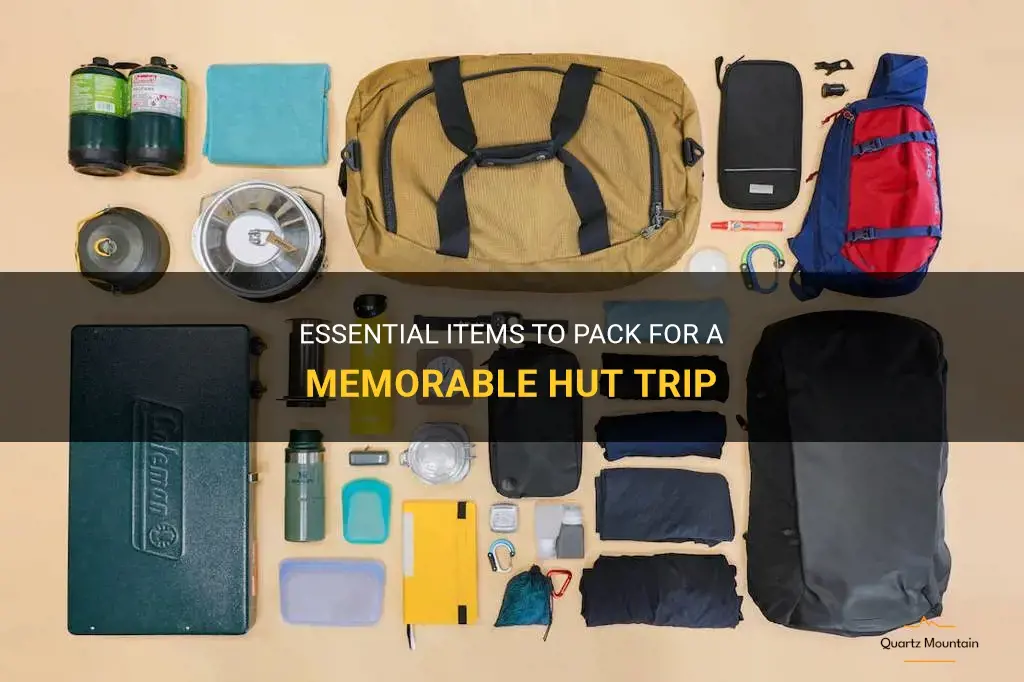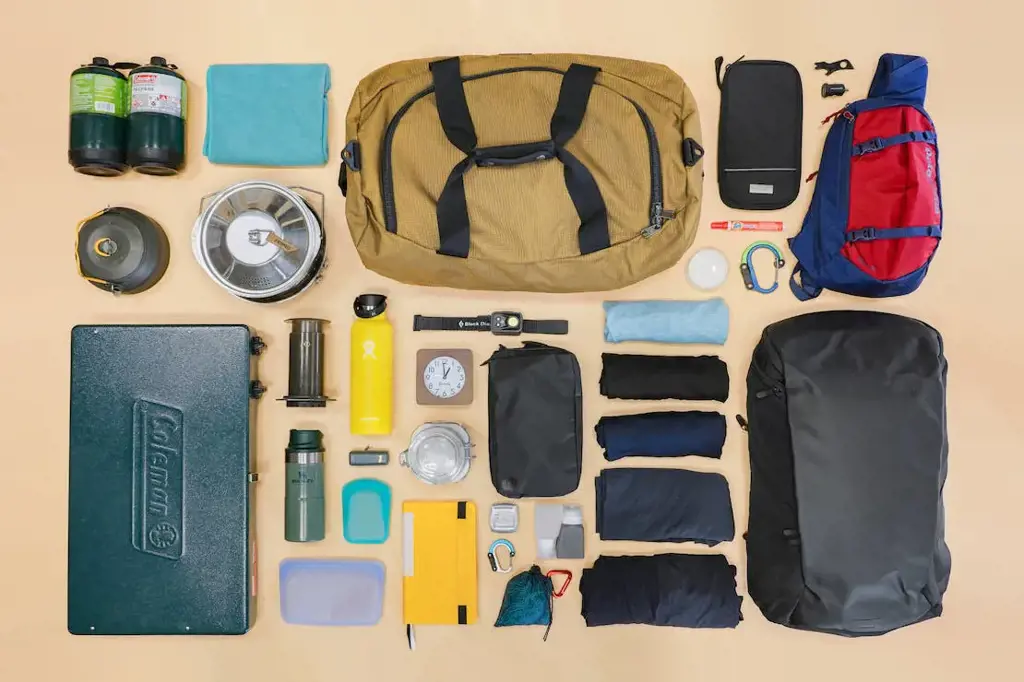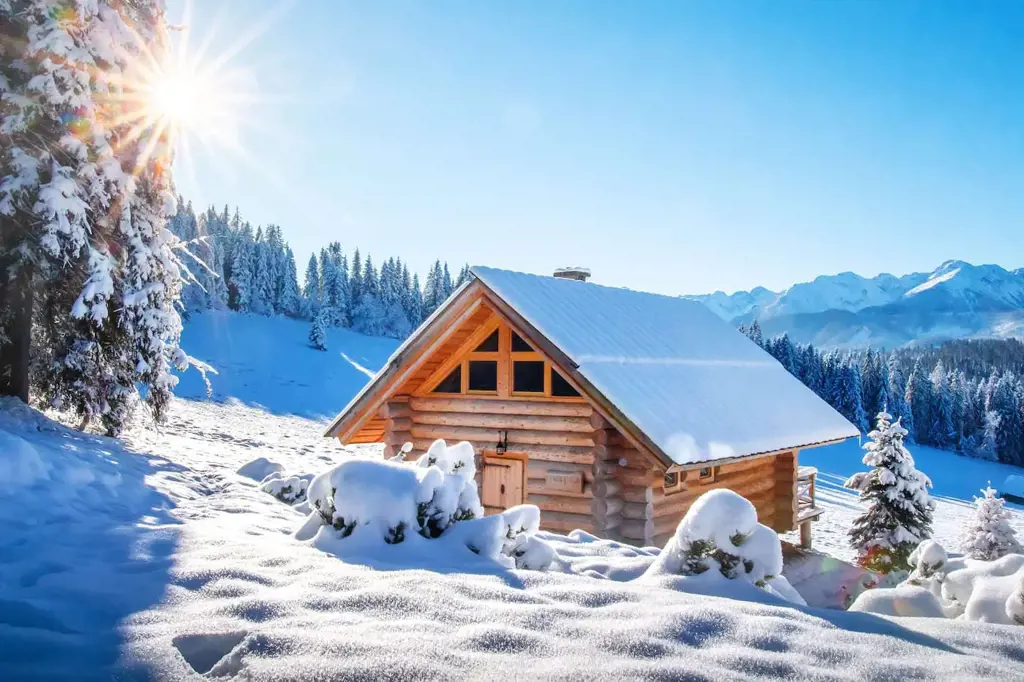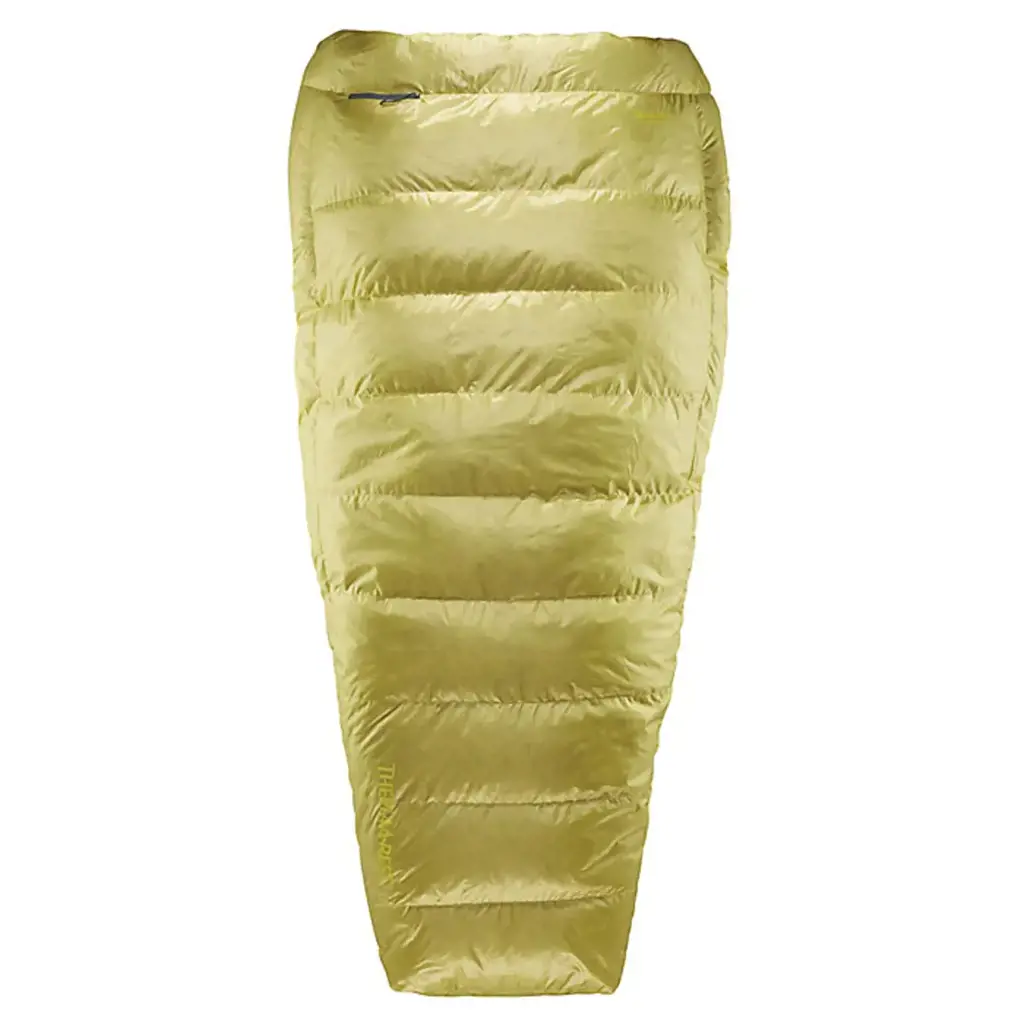
Are you dreaming of a cozy hut trip in the mountains? Whether you're an experienced outdoors enthusiast or a newbie looking for a thrilling adventure, packing the right essentials is crucial for a memorable experience. From warm clothing and sturdy boots to delicious trail snacks and reliable navigation tools, this guide will highlight the must-have items you need to pack to ensure a successful and unforgettable hut trip. So, grab your backpack and get ready for an exciting journey into nature's beautiful refuge.
What You'll Learn

What are the essential items to pack for a hut trip?

Going on a hut trip can be an exciting and fulfilling experience, but it's important to come well-prepared. Whether you're going on a skiing, hiking, or backpacking trip, there are some essential items that you should always pack. In this article, we will explore the must-have items for a successful hut trip.
- Backpack: A good quality backpack is essential for carrying all your gear and supplies. Choose a backpack with a capacity that fits your needs and make sure it is comfortable to wear for long periods of time.
- Clothing: Layering is crucial for any outdoor adventure. Pack moisture-wicking base layers, insulating mid-layers, and a waterproof and windproof outer layer. Don't forget to bring extra socks as well.
- Sleeping bag and pad: Since huts often have limited bedding, it's important to bring your own sleeping bag and pad. Look for a sleeping bag that is rated for the expected temperature range and a sleeping pad that provides insulation and cushioning.
- Food and water: Pack plenty of non-perishable food items that are easy to prepare, such as trail mix, energy bars, and dehydrated meals. It's also important to bring a water filter or purification tablets to ensure a safe water supply.
- Navigation tools: Depending on the difficulty of your trip, you may need a map, compass, and/or GPS device to navigate your way to the hut. Familiarize yourself with the area before you go and study the route in advance.
- First aid kit: Accidents can happen, so it's essential to have a well-stocked first aid kit. Include items such as bandages, adhesive tape, pain relievers, antiseptic wipes, and any necessary prescription medications.
- Lighting: Bring a headlamp or flashlight with extra batteries for navigating in low light conditions or during emergencies. It's always better to be safe than sorry when it comes to lighting.
- Tools and equipment: Depending on your chosen activity, you may need specific tools and equipment. For skiing, pack avalanche safety gear including a beacon, shovel, and probe. For hiking or backpacking, essentials may include a multi-tool, trekking poles, and a stove for cooking.
- Hygiene and personal care items: Don't forget to pack items such as toilet paper, hand sanitizer, toothbrush and toothpaste, and any other personal care items you may need.
- Communication devices: In case of emergencies, it's always important to have a means of communication. Bring a fully charged cell phone, a portable charger, and consider investing in a satellite communication device for remote areas where cell reception may be limited.
- Extra supplies: It's always a good idea to bring extra supplies such as duct tape, extra batteries, and rope. These items can come in handy in emergency situations or for quick repairs.
Remember, before embarking on any hut trip, do thorough research and consult experienced individuals or resources to ensure you are well-prepared. Each trip may have its unique requirements, so tailor your packing list accordingly. Stay safe and enjoy your hut adventure!
Essential Items for a 4 Day City Break: What to Pack
You may want to see also

How should I dress for a hut trip in cold weather?

Hut trips are a fun and adventurous way to enjoy the outdoors during the winter months. However, the cold weather can pose a challenge when it comes to choosing the right attire. It's important to dress appropriately to stay warm and comfortable during your hut trip. In this article, we will provide you with some science-backed tips on how to dress for a hut trip in cold weather.
Layering is key:
When it comes to dressing for cold weather, layering is the most effective way to stay warm. Start with a base layer made of moisture-wicking material such as merino wool or synthetic fabrics. This will help to keep your body dry by wicking away sweat. For the mid-layer, choose a fleece or down jacket to provide insulation. Finally, add an outer layer that is windproof and waterproof to protect you from the elements.
Don't forget about your extremities:
Your hands, feet, and head are particularly susceptible to the cold. Make sure to wear a warm hat or beanie to keep your head warm. For your hands, invest in a pair of insulated gloves or mittens. Consider wearing liner gloves underneath for added warmth. To keep your feet warm, wear thick wool socks and insulated boots. Consider using foot warmers if you tend to have particularly cold feet.
Pay attention to your lower body:
Your lower body is also prone to getting cold during a hut trip. Wear thermal or fleece-lined leggings as a base layer. Add an insulated and waterproof pair of pants as an outer layer. This will help to keep your legs warm and protected from the cold and wet conditions. Consider wearing gaiters to keep snow out of your boots and to provide an additional layer of insulation.
Choose the right materials:
When choosing your clothing for a hut trip, try to stick to natural or synthetic materials that provide good insulation and moisture-wicking properties. Avoid cotton as it tends to absorb moisture and can make you feel colder. Opt for materials like merino wool, synthetic fleece, or down, as they are known for their excellent insulation properties.
Don't forget about accessories:
Accessories can make a big difference in keeping you warm during a hut trip. Consider wearing a neck gaiter or scarf to protect your neck from the cold. A pair of sunglasses or goggles can help to protect your eyes from the glare of the snow and the wind. Don't forget to wear sunscreen as well, as the sun's rays can be particularly strong at high altitudes.
In conclusion, dressing appropriately for a hut trip in cold weather is crucial to stay warm and comfortable. By following these science-backed tips and layering your clothing, you can ensure that you stay cozy and enjoy your adventure to the fullest. Remember to choose the right materials, pay attention to your extremities, and don't forget about accessories to protect yourself from the cold. Stay safe and have fun on your hut trip!
What to Pack for an Alaska Cruise in August: Essential Items and Tips
You may want to see also

What type of sleeping bag should I bring for a hut trip?

When planning for a hut trip, one of the most important items to consider is your sleeping bag. The type of sleeping bag you choose will greatly impact your comfort and warmth during the trip. Here are some factors to consider when selecting a sleeping bag for a hut trip.
- Temperature Rating: The first thing to consider is the temperature rating of the sleeping bag. This rating indicates the lowest temperature at which a bag is designed to keep the average person warm. For hut trips, it's generally recommended to choose a sleeping bag with a temperature rating that is a few degrees lower than the expected nighttime temperature. This provides a safety margin and ensures you stay warm even if the temperature drops unexpectedly.
- Insulation Type: Sleeping bags come in two main insulation types: down and synthetic. Down insulation is made from the soft under feathers of ducks and geese and is known for its excellent warmth-to-weight ratio. It is lightweight, compressible, and retains heat efficiently. Synthetic insulation, on the other hand, is made from polyester fibers and is known for its ability to retain warmth even when wet. While down insulation is generally preferred for hut trips due to its superior warmth and compressibility, synthetic insulation can be a good option if you expect wet conditions or anticipate the possibility of getting your sleeping bag wet.
- Fill Power and Fill Weight: If you opt for a down sleeping bag, you should also consider the fill power and fill weight. Fill power refers to the quality of the down insulation and indicates its ability to loft or fluff up and trap warm air. Higher fill power translates to better insulation. Fill weight, on the other hand, refers to the quantity of down used in the bag. A higher fill weight means more insulation and warmth. It's important to strike a balance between fill power and fill weight to ensure you have a warm, yet lightweight and packable sleeping bag.
- Bag Shape and Length: Sleeping bags come in different shapes, including mummy, rectangular, and semi-rectangular. Mummy bags are the most common and offer the best warmth-to-weight ratio. They wrap snugly around your body, reducing the amount of empty space your body needs to heat. Rectangular bags are roomier but less efficient in trapping heat. They are suitable for those who value comfort over weight savings. Finally, semi-rectangular bags offer a compromise between the two. When selecting a bag shape, consider your personal preference and the level of warmth you require. It's also essential to choose a bag length that matches your height to ensure a snug fit and maximum insulation.
- Additional Features: Look for additional features that can enhance your comfort and convenience. These may include a hood with drawstrings to seal in warmth, zipper draft tubes to prevent cold air from entering, insulated draft collars to prevent heat loss through the neck area, and stash pockets to keep small items handy.
In conclusion, when choosing a sleeping bag for a hut trip, it's crucial to consider the temperature rating, insulation type, fill power and weight, bag shape and length, and additional features. By selecting a bag that meets your specific needs and preferences, you can ensure a comfortable and warm night's sleep during your hut trip.
Essential Gear for a Successful Cous Deer Hunt
You may want to see also

Are there any specific food items I should bring for a hut trip?

When embarking on a hut trip, it's important to plan your food carefully to ensure that you have nourishing and delicious meals while enjoying the outdoors. While each hut trip may have its own unique characteristics, there are some general guidelines to keep in mind when selecting food items to bring along. Here are a few tips to help you choose the right food for your hut trip:
- Consider the length of your trip: The duration of your hut trip will determine how much food you need to bring. If you're going on a weekend getaway, you'll need less food compared to a week-long expedition. Plan your meals and snacks accordingly to avoid running out of food or carrying unnecessary extra weight.
- Opt for lightweight yet nutritious options: When hiking to a remote hut, it's essential to choose food items that are lightweight and easy to carry. Look for dehydrated or freeze-dried meals that require minimal cooking and add hot water to rehydrate. These meals are not only lightweight but also provide essential nutrients to fuel your adventure.
- Include a variety of foods: It's important to have a well-balanced diet during your hut trip. Include a variety of foods such as grains, proteins, fruits, and vegetables. Pack items like instant oatmeal, dried fruits, nuts, energy bars, and jerky for quick and easy snacks. For main meals, consider bringing pasta, rice, couscous, dried soup mixes, canned meat or fish, and powdered sauces.
- Plan for special dietary needs: If you have any dietary restrictions or food allergies, make sure to plan accordingly. There are many options available for gluten-free, vegan, and vegetarian diets. Prioritize foods that meet your dietary requirements and ensure you have enough to sustain you throughout the trip.
- Don't forget the essentials: In addition to your main meals, there are a few essential food items you shouldn't forget. These include cooking oil, spices, salt, pepper, and any other essential condiments that you enjoy. These small additions can make a big difference in flavor and overall meal enjoyment.
- Consider the cooking facilities: Before finalizing your food choices, consider the cooking facilities available at the hut. Some huts may have a well-equipped kitchen with stoves, pots, and pans, while others may have limited cooking options such as a campfire or a small stove. Choose food items that are suitable for the specific cooking facilities available.
- Pack the food strategically: When packing your food, consider the weight distribution and accessibility. Place heavier items at the bottom of your backpack and lighter items on top. Pack snacks in easily accessible pockets for quick energy boosts while on the go.
- Leave no trace: It's essential to follow Leave No Trace principles during your hut trip to minimize your impact on the environment. Avoid bringing excess packaging or single-use items. Repackage your food in reusable containers or bags to reduce waste.
By following these tips, you can ensure that your hut trip is filled with delicious and nutritious meals. Remember to plan and pack your food in advance to make the most of your time in the great outdoors. Happy hut trip!
Getting Ready for Summer Camp: Chief Little Turtle's Packing Checklist
You may want to see also

What kind of gear is necessary for a hut trip, such as skis or snowshoes?

Hut trips are a popular winter activity for outdoor enthusiasts. They offer a unique opportunity to disconnect from the chaos of everyday life and immerse oneself in the tranquility of nature. Whether you prefer skiing, snowshoeing, or a combination of both, proper gear is essential for a successful hut trip.
When it comes to transportation in the snowy backcountry, skis and snowshoes are the two primary options. Skis are the preferred choice for those with experience and a desire for more speed. They allow for efficient travel across both flat and hilly terrain, and they are particularly well-suited for long distances. Cross-country skis are a popular choice, as they offer good flotation and maneuverability. However, alpine touring skis can also be used if you plan to venture into steeper, more challenging terrain.
Snowshoes, on the other hand, provide excellent flotation and stability, making them ideal for traversing deep snow. They are suitable for individuals of all skill levels and offer a more relaxed, slower-paced experience. When selecting snowshoes, make sure to choose the appropriate size based on your weight and the anticipated snow conditions.
In addition to skis or snowshoes, there are several other gear items that are essential for a hut trip. Here is a comprehensive list of necessary gear:
- Backpack: A sturdy backpack is crucial for carrying all of your gear, snacks, and water.
- Clothing: Dressing appropriately for the weather is essential. Layering is key to staying warm and dry. Pack a base layer, insulating layer, and a waterproof outer layer. Don't forget hats, gloves, and extra socks.
- Sleeping bag: Most huts do not provide bedding, so a warm and lightweight sleeping bag is a must.
- Sleeping pad: A sleeping pad provides insulation between you and the cold ground, ensuring a more comfortable night's sleep.
- Food and water: Plan and pack your meals in advance. High-energy, non-perishable foods are ideal. Bring plenty of water or a water filtration system.
- Headlamp: A headlamp is essential for navigating the hut after dark or during early morning starts.
- Map and compass: Even if you are familiar with the area, it is crucial to carry a map and compass as a backup for navigation.
- First aid kit: Be prepared for potential injuries or emergencies by packing a comprehensive first aid kit.
- Sun protection: The sun can be intense in snowy environments, so pack sunscreen, sunglasses, and a hat for protection.
- Repair kit: A basic repair kit with tools and spare parts for your skis or snowshoes can be a lifesaver if equipment issues arise.
It is important to note that these gear recommendations are not exhaustive and may vary depending on the specific trip and personal preferences. It is always a good idea to consult with experienced hut trip enthusiasts or guides to ensure you have all the necessary gear for a safe and enjoyable outing.
In conclusion, skiing or snowshoeing are the primary modes of transportation for hut trips. Skis are ideal for experienced individuals seeking speed, while snowshoes offer a more relaxed pace and stability. In addition to skis or snowshoes, other essential gear includes a backpack, appropriate clothing, a sleeping bag, a sleeping pad, food and water, a headlamp, a map and compass, a first aid kit, sun protection, and a repair kit. Properly equipping yourself ensures a safe and enjoyable hut trip experience in the winter wilderness.
What You Need to Pack for VSG Surgery: Essential Items for a Successful Recovery
You may want to see also
Frequently asked questions
When packing for a hut trip, it's important to consider the specific location and weather conditions. Some general items to pack include warm clothing, sleeping bag, headlamp or flashlight, toiletries, first aid kit, food, water, and any necessary personal items. It's also a good idea to bring extra layers, as temperatures can fluctuate in the mountains. Additionally, don't forget to pack any required hut-specific items, such as a sleeping pad or cooking equipment, if they are not provided.
The amount of food you should bring for a hut trip depends on the length of your trip and the number of people in your group. It's a good idea to plan for three meals a day, plus snacks, and pack enough food to last for the entire duration of your trip. Consider packing lightweight and non-perishable items, such as dehydrated meals, trail mix, energy bars, and dried fruits. It's always better to pack a little extra than to run out of food while in the backcountry.
When it comes to clothing for a hut trip, it's important to be prepared for various weather conditions. Layering is key, as it allows you to adjust your clothing and stay comfortable throughout the day. Start with a base layer made of moisture-wicking material to keep you dry, add a mid-layer for insulation, and finish with a waterproof and windproof outer layer. Don't forget to pack warm hats, gloves, socks, and a good pair of snow boots or hiking boots. Also, consider packing a couple of additional layers, such as a down jacket or fleece, for colder temperatures.







